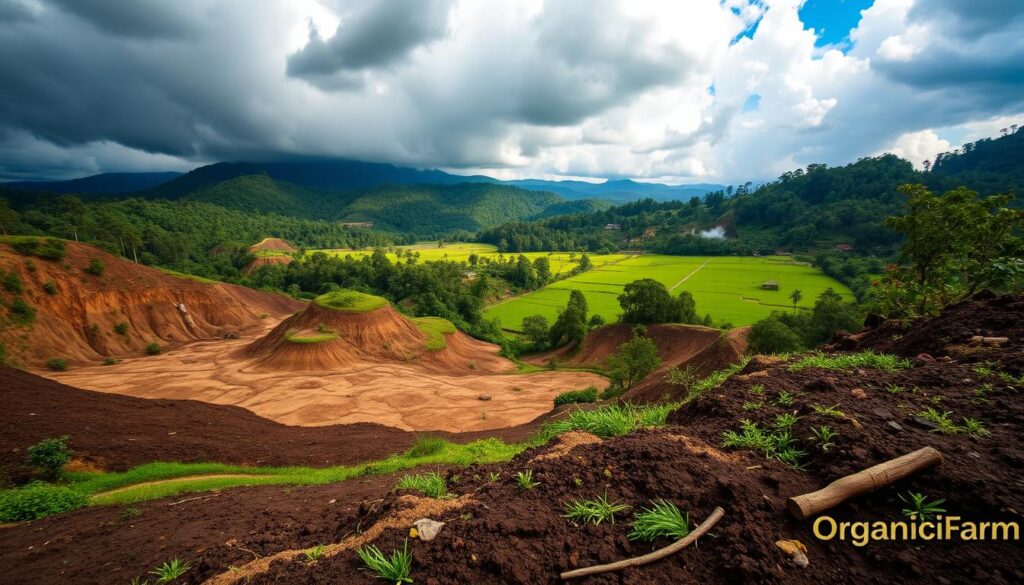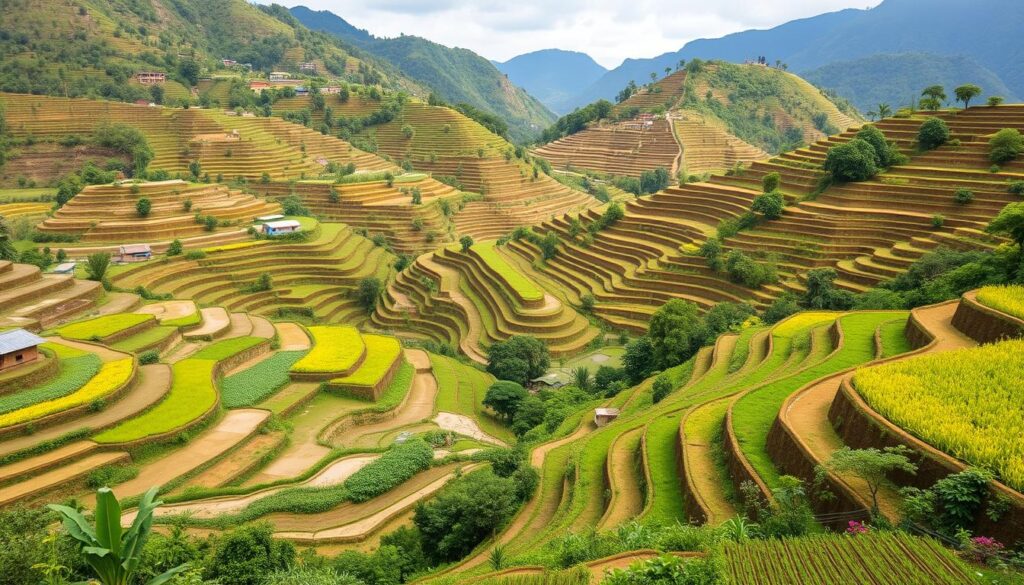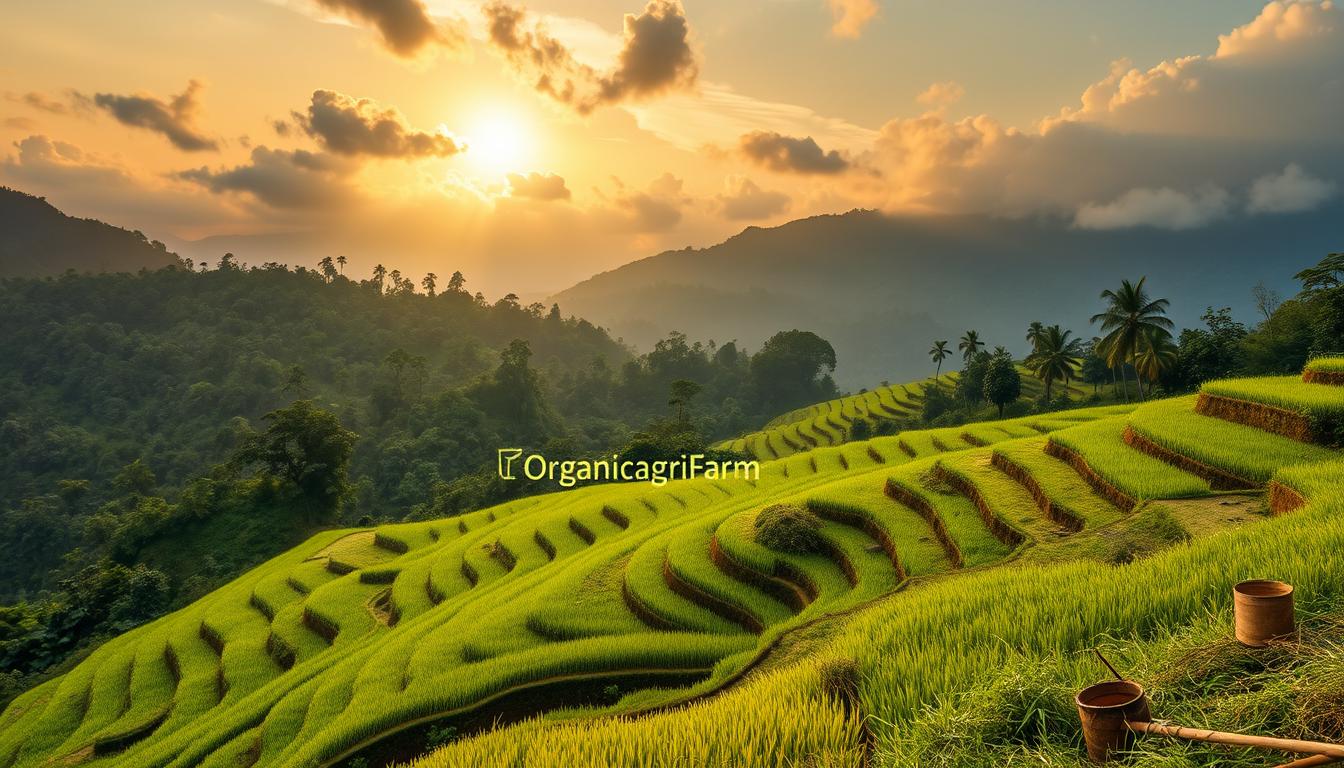In Arunachal Pradesh, about 40% of the people use jhum cultivation. This traditional farming method has been passed down for generations. It’s a key part of the state’s economy and culture, linked to farming traditions in northeast India.
Jhum cultivation involves clearing land, burning vegetation, and planting crops. It’s a complex and important practice.
Jhum cultivation has a long history in Arunachal Pradesh. It’s a hard process that needs skill and knowledge. Tribal communities in the area often practice it.
By learning about jhum cultivation in Arunachal Pradesh, we understand its cultural and economic value. It shows the importance of traditional farming in northeast India.
Key Takeaways
- Jhum cultivation is a traditional farming practice that involves clearing land, burning vegetation, and planting crops.
- It is practiced by approximately 40% of the population in Arunachal Pradesh.
- Jhum cultivation is closely tied to traditional farming practices in northeast india.
- The practice has a rich history and cultural significance in the region.
- Jhum cultivation is often practiced by tribal communities in Arunachal Pradesh.
- It is a labor-intensive process that requires great skill and knowledge.
- Jhum cultivation plays a vital role in the state’s economy and culture.
Understanding the Ancient Practice of Jhum Cultivation
Jhum cultivation has been a key part of Northeast India’s culture for centuries. It’s a traditional farming way that clears land by burning vegetation. Then, it’s used for a few years before moving to new areas. The indigenous farming techniques used in Jhum cultivation have been passed down through generations.
Each community has adapted this method to fit their specific needs and environment. This shows the deep connection between the land and the people.
The history of Jhum cultivation is deeply connected to the region’s culture and society. It’s a shifting cultivation method that makes the most of land fertility. It also helps avoid soil degradation.
By rotating crops and letting the land rest, farmers keep the soil healthy. This ensures a steady supply of nutrients for their crops.
Historical Origins and Evolution
Research shows Jhum cultivation has been around in Northeast India for over 1,000 years. Over time, farmers have added new techniques and tools to improve yields and reduce labor. Despite its long history, Jhum cultivation remains crucial in the region’s agriculture.
Cultural Significance in Northeast India
Jhum cultivation is more than just farming; it’s a big part of the region’s cultural heritage. It’s linked to social and religious rituals, with many festivals and ceremonies tied to planting and harvesting. By keeping this traditional method alive, communities in Northeast India can also keep their cultural identity and connection to the land strong.
Traditional Features and Characteristics of Jhum Farming
Jhum cultivation is a key farming method in northeast India. It has been around for centuries. This farming way involves burning vegetation to clear land and then growing crops.
It uses simple tools like digging sticks and hoes. Farmers also rely on natural fertilizers, like ash and compost.
In Arunachal Pradesh, Jhum farming varies among different tribes. Each tribe has its own way of doing it. Some common traits include:
- Shifting cultivation: Farmers clear new land every few years. This lets the old land rest and get fertile again.
- Use of local crop varieties: Farmers grow crops like rice, maize, and millet. These are perfect for the local climate and soil.
- Integration with forest ecosystem: Jhum farming works with the forest. Farmers use forest products for their farming needs.
Jhum cultivation is crucial for northeast India’s ecology and biodiversity. It’s not just a job for local communities. It also keeps the region’s culture alive.
| Type of Jhum Cultivation | Characteristics |
|---|---|
| Shifting Jhum | Clearing new land every few years, allowing previous land to lie fallow |
| Permanent Jhum | Cultivating the same land continuously, using fertilizers and irrigation |
Jhum Cultivation in Arunachal Pradesh: A Comprehensive Overview
Jhum cultivation in Arunachal Pradesh is a farming tradition that has lasted for centuries. It’s not just a way to make a living but also a big part of the area’s culture. This farming method uses sustainable agriculture to keep the soil fertile and protect natural resources.
The tribal communities in Arunachal Pradesh are key to jhum cultivations. They know the land and the seasons well. This knowledge helps them choose the right crops and farming methods. The seasonal patterns in Arunachal Pradesh mean heavy rain in summer and dry winters. This affects what crops are grown, with rice, maize, and millet being favorites in summer.
Some special things about jhum cultivation in Arunachal Pradesh include:
- Use of organic farming techniques
- Conservation of natural resources
- Promotion of biodiversity
- Empowerment of tribal communities
Lately, there’s more interest in sustainable agriculture in Arunachal Pradesh, focusing on jhum cultivation. This has sparked new projects and programs. They aim to support tribal communities and encourage jhum cultivation.
| Season | Crops | Farming Techniques |
|---|---|---|
| Summer | Rice, Maize, Millet | Use of organic fertilizers, crop rotation |
| Winter | Vegetables, Fruits | Use of mulching, composting |
Environmental Impact and Sustainability Challenges
Jhum cultivation can harm the environment by causing deforestation and soil erosion. Conservation of biodiversity through jhum cultivation is possible but needs careful planning. Research shows jhum cultivation can have both good and bad effects on the environment.
Some major environmental impacts of jhum cultivation include:
- Deforestation and habitat loss
- Soil erosion and degradation
- Loss of biodiversity
- Water pollution
Yet, with the right management, jhum cultivation can also help protect biodiversity. For instance, using crop rotation and agroforestry can keep soil fertile and support biodiversity.

A study on jhum cultivation’s environmental impact found it can significantly affect the environment. But, with good management and conservation, these effects can be lessened. The study suggested jhum cultivators adopt sustainable practices like natural fertilizers and fewer chemical pesticides.
| Environmental Impact | Positive Effects | Negative Effects |
|---|---|---|
| Deforestation | None | Habitat loss, soil erosion |
| Soil Erosion | None | Soil degradation, loss of fertility |
| Biodiversity | Promotion of biodiversity through agroforestry | Loss of biodiversity due to habitat destruction |
Comparative Analysis: Jhum Practices in Karbi Anglong and Assam
Jhum cultivation in Arunachal Pradesh is unique, but it’s also interesting to see how it’s done in Karbi Anglong and Assam. In Northeast India, farming practices vary due to the region’s geography and culture.
In Karbi Anglong, jhum cultivation is key to the local economy and culture. The area uses slash-and-burn techniques to clear land and make soil rich. This method works well in the hills and is used by many tribes.
Distinctive Features of Karbi Anglong Methods
- Use of slash-and-burn techniques for land clearing
- Emphasis on crop rotation and soil conservation
- Integration with other farming practices, such as livestock rearing
In Assam, jhum cultivation has changed, with more focus on sustainable farming. The state government supports eco-friendly farming to lessen environmental harm.
Assamese Variations and Adaptations
Assam’s jhum practices reflect the state’s culture and geography. While traditional tools are still used, many farmers now use modern methods to boost yields and save on labor.
| Region | Distinctive Features | Sustainability Initiatives |
|---|---|---|
| Karbi Anglong | Slash-and-burn techniques, crop rotation | Government support for eco-friendly farming |
| Assam | Traditional farming tools, modern methods | State initiatives for sustainable jhum cultivation |
By comparing jhum practices in Karbi Anglong and Assam, we learn about the diversity of farming in Northeast India. This understanding helps in promoting sustainable agriculture and supporting local communities.
Modern Adaptations in Tura and Surrounding Regions
In Tura, Jhum cultivation is changing to face today’s challenges. Sustainable agriculture practices are becoming key. These include indigenous farming techniques that have been passed down for generations.
Some major changes in Tura include:
- Use of organic fertilizers and pesticides
- Implementation of crop rotation and intercropping
- Promotion of sustainable agriculture in arunachal pradesh through community-led initiatives
The importance of indigenous farming techniques in these changes is huge. By using these traditional methods, farmers in Tura can lessen their environmental impact. They also see better crop yields. As one farmer said, “By using indigenous farming techniques, we can ensure the long-term sustainability of our farms and the environment.”

The future of Jhum cultivation in Tura and nearby areas looks bright. With more sustainable agriculture practices and indigenous farming techniques, these communities can grow and protect the environment.
Government Initiatives and Support Systems
The government has launched several initiatives to support Jhum cultivation. They recognize its cultural value and its effect on the environment. These efforts aim to promote sustainable farming and lessen the negative environmental impact.
They provide technical help and training to farmers. This helps them use more efficient and eco-friendly farming methods.
Some key initiatives include:
- Community development programs, which offer financial support and resources to farmers
- Technical assistance and training, to help farmers adopt more sustainable practices
- Research and development, to improve crop yields and reduce the environmental impact of jhum cultivation
The cultural importance of jhum cultivation is also being recognized and preserved. The government is working to promote traditional practices and knowledge. They also encourage farmers to use modern, sustainable methods.
By supporting farmers, the government aims to lessen the negative environmental impact of jhum cultivation. They hope to create a more sustainable future for this traditional practice. Their efforts are a positive step, and they are expected to benefit the environment and communities that depend on jhum cultivation.
| Initiative | Objective | Benefits |
|---|---|---|
| Community development programs | Provide financial support and resources to farmers | Improved livelihoods, increased crop yields |
| Technical assistance and training | Help farmers adopt more sustainable practices | Reduced environmental impact, improved crop quality |
| Research and development | Improve crop yields and reduce environmental impact | Increased food security, reduced poverty |
Conclusion: The Future of Jhum Cultivation in Northeast India
Jhum cultivation in Arunachal Pradesh and Northeast India’s traditional farming face big challenges. Yet, they also hold a key to a sustainable future. By mixing old wisdom with new, eco-friendly methods, jhum farming can thrive.
Tribal communities have made jhum farming strong for many years. Now, it’s time for a new chapter. Sustainable practices, modern tech, and teamwork between locals and governments can save jhum farming.
As we end this journey, we feel hopeful. The traditions of Northeast India will keep shaping farming. They show the strength and spirit of these communities.
